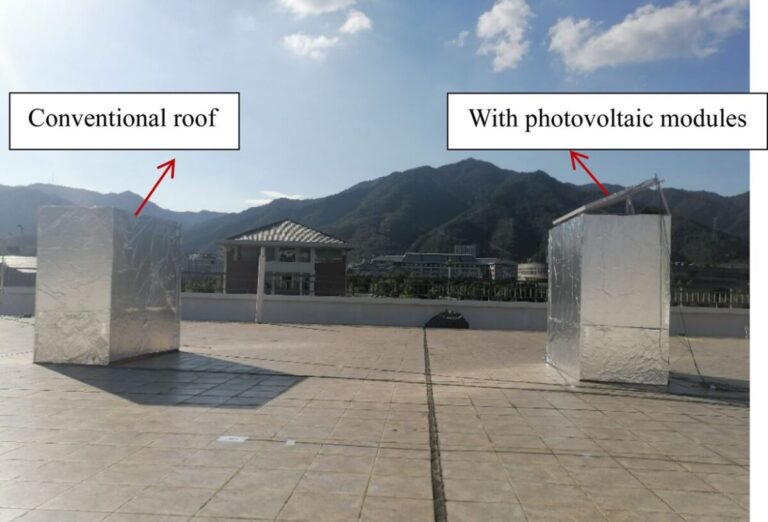Researchers in China have investigated the effect of the overhead height and tilt corner on thermal and energy -saving performance of photovoltaic roof and have discovered that the extensive energy -saving efficiency of parallel overhead photovoltaic roofs are optimal in the summer and the worst in winter.
Researchers from the Chinese Guilin University of Electronic Technology have presented a new model to investigate the impact of various overhead heights and tilting corners of PV modules at thermal and electrical performance and energy-saving rooms.
The accuracy of the numerical model was verified by an experimental model.
“An extensive study on the influence of different overhead heights and tilting angles on annual thermal and electrical performance is missing in literature, while such a study is essential to understand the obstacles during the design of photovoltaic roofs,” the team said. “In addition, earlier studies concentrate on the energy -saving benefits of photovoltaic roofs in specific installation types, but there is a lack of research into the extensive performance in different installation types.”
The numerical model has been developed in the design builder software, which can take into account different energy checks inside and outdoor buildings, including multiple forms of heat transfer, such as guide, convection and radiation. Local meteorological data from the Northeast Chinese city of Guilin were used.
An enclosed structure without PV on top is compared to a true height and tilt corner of PV modules.
“The housing structure of the simulation room used a layer of plywood with a thickness of 1.5 cm,” the group said. “To simulate the reflection effect of aluminum foil around the building, a 0.01 cm thick reflective layer with a reflectivity of 0.90 is constructed around the housing structure. The photovoltaic module is a 200 W monocrystalline silicon photovoltaic panel. “
The experimental rig used plywood of 1,850 mm x 950 mm x 1,850 mm, with a thickness of 15 mm. Aluminum foil covered the surface of the test installation to reduce heat disipation due to the enclosing structure, and the PV modules had dimensions of 1,580 mm x 808 mm x 35 mm. It was measured against the simulated model with an overhead height of 200 mm and a tilt angle 25R for the PV panel.
Image: Guilin University of Electronic Technology, Results in Engineering, CC BY 4.0
“The root average square error (RMSE) and average absolute percentage error (MAPE) of the roof with photovoltaic modules are 0.16-2.35 and 0.90%-9.38%,” the scientists said. “In the meantime, the RMSE and Mape of the conventional roofs are 0.42-2.55 and 0.95%–8.89%. It is shown that the model set out in this article is reliable. “
Based on these results, the researchers changed the high and corner parameters into the simulation. To check the height impact, the academics repaired the panel on a parallel setting and checked it under 100 mm, 150 mm and 200 mm. On the other hand, they checked different slope angles under a height of 200 mm. Namely 0 °, 15 °, 20 °, 25 °, 30 °, 35 °, 40 °, 45 °.
“Due to the difference in solar height angle between summer and winter, the daily power generation (EPVR) of parallel overhead photovoltaic roofs is optimal (307.2 W/m2) in the summer, and the EPVR is decreasing with the increase in the spot angle,” ” explained. “The EPVR is the worst in the winter, while the profit of an oblique overhead power supply shows a single peak trend. The reinforcement of the sloping photovoltaic roof above the head at 40 ° Rebt best (234.6 W/m2) and then shows a downward trend. “
In the summer they also discovered that the daily energy-saving efficiency of the PV roof is the highest, with 18.8%. As the tilt angle increases, the efficiency of sloping upper roofs shows a downward trend. In the winter, the optimum efficiency is found at a slope of 40Z, by 25.6%, while the parallel case is the lowest.
“The optimum power supply increase and extensive energy-saving efficiency are achieved throughout the year by a tile angle of 20 °, with EPVR value of 79.4 kW⋅h/m2 and efficiency of 25.5%,” the team concluded. “The results indicate that adjusting the overhead height somewhat influences the difference of daily cooling load between conventional and photovoltaic roofs, with a negligible impact on the total energy -saving efficiency (less than 0.2%).”
Their findings were presented in “Effect of the overhead height and tilt corner on extensive performance of photovoltaic roof based on simulation and experimental methods“Published in Results in Engineering.
This content is protected by copyright and may not be reused. If you want to work with us and reuse part of our content, please contact: editors@pv-magazine.com.
Popular content



